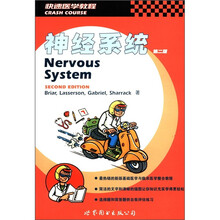神经系统(第2版快速医学教程)

目 录内容简介
Preface
Acknowledgements
Dedication
Part Ⅰ: Basic Medical Science of the Nervous system
1.Overview of the Nervous System
Introduction
Anatomy of the central nervous system
Overall development of the nervous system
The central nervous system environment
2.Cellular Physiology of the Nervous System
Neuronal structure and function
Neuronal excitation and inhibition
Synaptic transmission
Damage and repair in the nervous system
3.The Spinal Cord
The spinal cord
The spinal tracts
4.Soma to sensation and the
Perception of Pain
Soma to sensation and the sensory cortex
5.Motor Control
Movement control
Motor units and the recruitment of muscles fibers
Reflex action and muscle tone
The motor cortex
Basal ganglia and thalamus
The cerebellum
The vestibular system, posture and locomotion
6.The Brainstem
The brainstem nuclei
The reticular formation
Function of the reticular formation
Brain death
7.The Autonomic Nervous System
Introduction
Structure and function of the sympathetic nervous system
Structure and function of the parasympathetic nervous system
The enteric nervous system
Disorders of the autonomic nervous system.
8.Vision
The eye
Retinal function and image processing
Central visual pathways and the visual cortex
Attention and perception
Loss of vision
9.Hearing
The ear and conduction of sound
The central auditory pathways and the auditory cortex
Loss of hearing
10.Olfaction and Taste
Receptors for smell and taste
Central pathways of smell and taste
11.Basic Pathology
Common pathological features of the central nervous system
Malformations, developmental disease and prenatal injury
Trauma of the central nervous system
Cerebrovascular disease
Infections of the central nervous system
Demyelization and degeneration
Metabolic disorders and toxins
Neoplasm's of the central nervous system
Epilepsy
12.Pathology of the Peripheral Nerves and Muscles
Hereditary neuropathies
Traumatic neuropathies
Inflammatory neuropathies
Infectious neuropathies
Metabolic and toxic neuropathies
Neurocutaneous syndromes
Diseases of the muscles and neuromuscular junction
13.Higher Centers of the Central Nervous System
Localization of function and behavior Learning and memory
The limbic system
Cognitive development and degeneration
Pharmacology of higher central nervous system function
Brainstem-acting drugs and general aesthetics
Part Ⅱ: Clinical Assessment
14.Common Presentation of Neurological Disease
Common presenting complaints
15.The Neurological Assessment
Beginning the interview
The structure of the history
Communication skills
The neurological examination
16.Further Investigations
Neurophysiologic investigations
Routine investigations
Imaging of the nervous system
Part Ⅲ: Self-assessment
Multiple-choice Questions (MCQs)
Short-answer Questions (SAQs)
Essay Questions
MCQ Answers
SAQ Answers
Index
Acknowledgements
Dedication
Part Ⅰ: Basic Medical Science of the Nervous system
1.Overview of the Nervous System
Introduction
Anatomy of the central nervous system
Overall development of the nervous system
The central nervous system environment
2.Cellular Physiology of the Nervous System
Neuronal structure and function
Neuronal excitation and inhibition
Synaptic transmission
Damage and repair in the nervous system
3.The Spinal Cord
The spinal cord
The spinal tracts
4.Soma to sensation and the
Perception of Pain
Soma to sensation and the sensory cortex
5.Motor Control
Movement control
Motor units and the recruitment of muscles fibers
Reflex action and muscle tone
The motor cortex
Basal ganglia and thalamus
The cerebellum
The vestibular system, posture and locomotion
6.The Brainstem
The brainstem nuclei
The reticular formation
Function of the reticular formation
Brain death
7.The Autonomic Nervous System
Introduction
Structure and function of the sympathetic nervous system
Structure and function of the parasympathetic nervous system
The enteric nervous system
Disorders of the autonomic nervous system.
8.Vision
The eye
Retinal function and image processing
Central visual pathways and the visual cortex
Attention and perception
Loss of vision
9.Hearing
The ear and conduction of sound
The central auditory pathways and the auditory cortex
Loss of hearing
10.Olfaction and Taste
Receptors for smell and taste
Central pathways of smell and taste
11.Basic Pathology
Common pathological features of the central nervous system
Malformations, developmental disease and prenatal injury
Trauma of the central nervous system
Cerebrovascular disease
Infections of the central nervous system
Demyelization and degeneration
Metabolic disorders and toxins
Neoplasm's of the central nervous system
Epilepsy
12.Pathology of the Peripheral Nerves and Muscles
Hereditary neuropathies
Traumatic neuropathies
Inflammatory neuropathies
Infectious neuropathies
Metabolic and toxic neuropathies
Neurocutaneous syndromes
Diseases of the muscles and neuromuscular junction
13.Higher Centers of the Central Nervous System
Localization of function and behavior Learning and memory
The limbic system
Cognitive development and degeneration
Pharmacology of higher central nervous system function
Brainstem-acting drugs and general aesthetics
Part Ⅱ: Clinical Assessment
14.Common Presentation of Neurological Disease
Common presenting complaints
15.The Neurological Assessment
Beginning the interview
The structure of the history
Communication skills
The neurological examination
16.Further Investigations
Neurophysiologic investigations
Routine investigations
Imaging of the nervous system
Part Ⅲ: Self-assessment
Multiple-choice Questions (MCQs)
Short-answer Questions (SAQs)
Essay Questions
MCQ Answers
SAQ Answers
Index
目 录内容简介
《快速医学教程:神经系统(第2版)》首先引领你学习神经系统的基础知识。每章都采用了整合形式,即将解剖学、胚胎学、组织学、生理学与药理学加以综合。然后概述了神经系统的基本病理学,并列举一些主要疾病及其主诉。第二部分则通过对现有神经系统主诉患者的临术分析,将基础知识与临床应用加以整合,包括神经疾病最常见的主诉,如何采集病史、体检、与患者的沟通技巧及进一步的诊断方案。由选择题、简答题和问题组成的第三部分则能让你在学完本课程以后评估你取得的进步和你的水平。
比价列表
公众号、微信群
 缺书网
缺书网微信公众号
 扫码进群
扫码进群实时获取购书优惠







